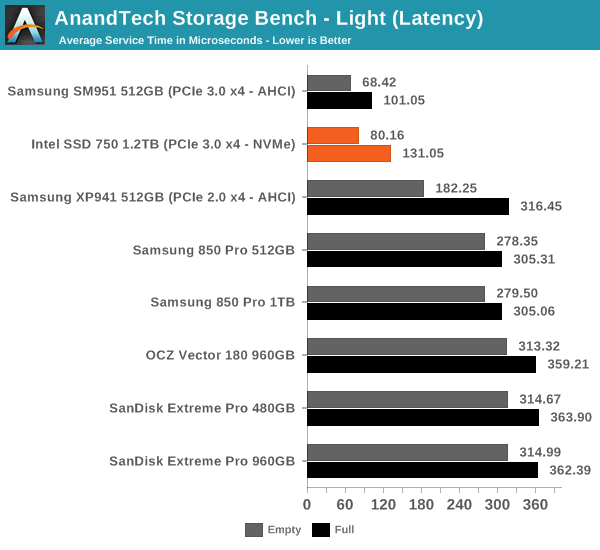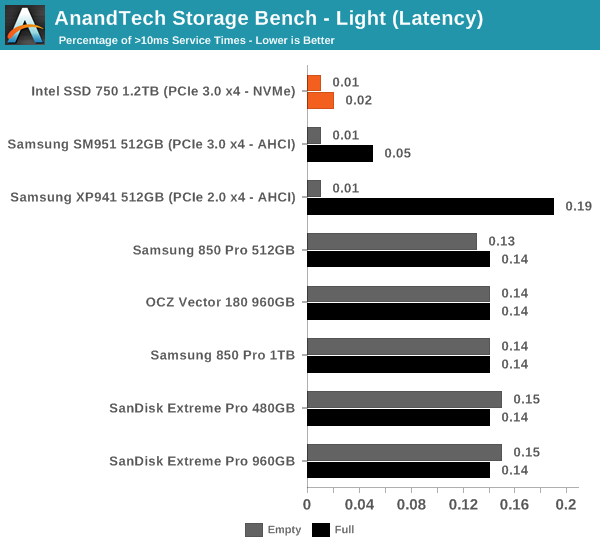Intel SSD 750 PCIe SSD Review: NVMe for the Client
by Kristian Vättö on April 2, 2015 12:00 PM ESTAnandTech Storage Bench - Light
The Light trace is designed to be an accurate illustration of basic usage. It's basically a subset of the Heavy trace, but we've left out some workloads to reduce the writes and make it more read intensive in general.
| AnandTech Storage Bench - Light - Specs | ||||||||||||
| Reads | 372,630 | |||||||||||
| Writes | 459,709 | |||||||||||
| Total IO Operations | 832,339 | |||||||||||
| Total GB Read | 17.97 GB | |||||||||||
| Total GB Written | 23.25 GB | |||||||||||
| Average Queue Depth | ~4.6 | |||||||||||
| Focus | Basic, light IO usage | |||||||||||
The Light trace still has more writes than reads, but a very light workload would be even more read-centric (think web browsing, document editing, etc). It has about 23GB of writes, which would account for roughly two or three days of average usage (i.e. 7-11GB per day).
| AnandTech Storage Bench - Light - IO Breakdown | |||||||||||
| IO Size | <4KB | 4KB | 8KB | 16KB | 32KB | 64KB | 128KB | ||||
| % of Total | 6.2% | 27.6% | 2.4% | 8.0% | 6.5% | 4.8% | 26.4% | ||||
The IO distribution of the Light trace is very similar to the Heavy trace with slightly more IOs being 128KB. About 70% of the IOs are sequential, though, so that is a major difference compared to the Heavy trace.
| AnandTech Storage Bench - Light - QD Breakdown | ||||||||||||
| Queue Depth | 1 | 2 | 3 | 4-5 | 6-10 | 11-20 | 21-32 | >32 | ||||
| % of Total | 73.4% | 16.8% | 2.6% | 2.3% | 3.1% | 1.5% | 0.2% | 0.2% | ||||
Over 90% of the IOs have a queue depth of one or two, which further proves the importance of low queue depth performance.

The same trend continues in our Light trace where the SM951 is still the king of the hill. It's obvious that Intel didn't design the SSD 750 with such light workloads in mind as ultimately you need to have a relatively IO intensive workload to get the full benefit of PCIe and NVMe.












132 Comments
View All Comments
KAlmquist - Thursday, April 2, 2015 - link
It's too bad that Anandtech didn't benchmark the 400 GB model, since that's the one most people are going to be most interested in buying. I assume that it's a case of Intel not making the 400 GB model available for review, rather than Anandtech deciding not to review it.jwilliams4200 - Thursday, April 2, 2015 - link
Agreed, the 400 GB model is more interesting to consumers.Also, I hope that if Anandtech does test the 400GB model, that they re-run the tests of the comparison SSDs so that the competitors are overprovisioned to 400GB usable capacity (from 512GB or whatever nominal capacity). That is the only reasonable way to compare, since anyone who wants high sustained performance and is willing to try a drive with only 400GB to achieve it would obviously be willing to overprovision, for example, a 512GB Samsung 850 Pro to only 400GB usable to achieve higher sustained performance.
Kristian Vättö - Thursday, April 2, 2015 - link
That is something that I've had on my mind for a while now and I even have a way to do it now (the Storage Bench traces are a bit tricky since they are run on a raw drive, but thankfully I found an hdparm command for limiting the far LBA count). The only issue is time because it takes roughly two days to test one drive through the 2015 suite, so I may be include a drive or two as comparison points but I definitely can't test all drives with added OP.Kristian Vättö - Thursday, April 2, 2015 - link
Not far LBA count, but raw LBA count, obviously :)Stahn Aileron - Friday, April 3, 2015 - link
Honestly, I'd rather have AnandTech test drives and components as-is ("stock" from the manufacturer) and publish those results rather than spend time doing tests on non-standard, customized configurations. Let the customers do that if they truly need that type of set-up or leave it to integrators/specialists.As far as I know, most customers of a product just want to use it immediately right of the box, no mucking with special settings. Most products are advertised that way as well.
Really, just test the product(s) as advertised/intended by the manufacturer first and foremost to see if it matches their claims and properly serves the target userbase. Specialty cases should only be done if that is actively advertised as a feature, there is truly high interest, something makes you curious, and/or you have the time.
jwilliams4200 - Friday, April 3, 2015 - link
If this were a review site for the totally clueless, then you might have a point. But anandtech has always catered to enthusiasts and those who either already know a lot about how computer equipment works, or who want to learn.The target audience for this site would certainly consider something as simple as overprovisioning an SSD if it could significantly increase performance and/or achieve similar performance at lower cost relative to another product. So it makes sense to test SSDs configured for similar capacity or performance rather than just "stock" configuration. Anyone can take an SSD and run a few benchmarks. It takes a site as good as anandtech to go more in-depth and consider how SSDs are actually likely to be used and then present useful tests to its readers.
Kristian Vättö - Thursday, April 2, 2015 - link
That is correct. I always ask for all capacities, but in this case Intel decided to sample all media with only 1.2TB samples. I've asked for a 400GB, though, and will review it as soon as I get it.Mr Alpha - Thursday, April 2, 2015 - link
Has anyone managed to find this mythological list of compatible motherboards?Kristian Vättö - Thursday, April 2, 2015 - link
I just asked Intel and will provide a link as soon as I get one. Looks like it's not up yet as they didn't have an answer right away.tstones - Thursday, April 2, 2015 - link
Older chipsets like z77 and z87 will support NVMe?